Management of International Finance
VerifiedAdded on 2023/01/05
|15
|5033
|27
AI Summary
This article discusses the management of international finance, focusing on the portfolio investments of China and India. It explores the outperformance of India and China, driven by FPI flows. The implications of these investments and the appropriate financial concepts, theory, and practices are also discussed.
Contribute Materials
Your contribution can guide someone’s learning journey. Share your
documents today.
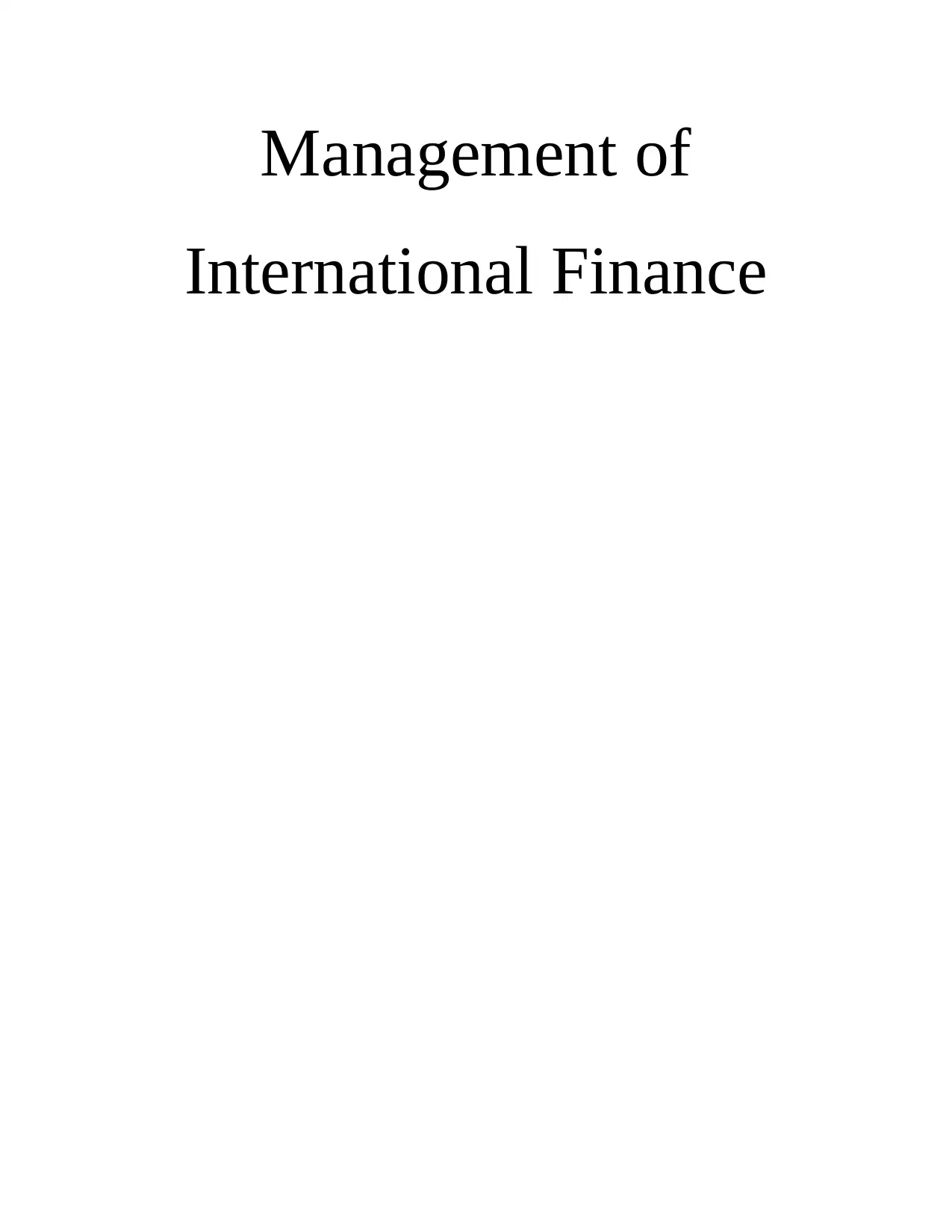
Management of
International Finance
International Finance
Secure Best Marks with AI Grader
Need help grading? Try our AI Grader for instant feedback on your assignments.
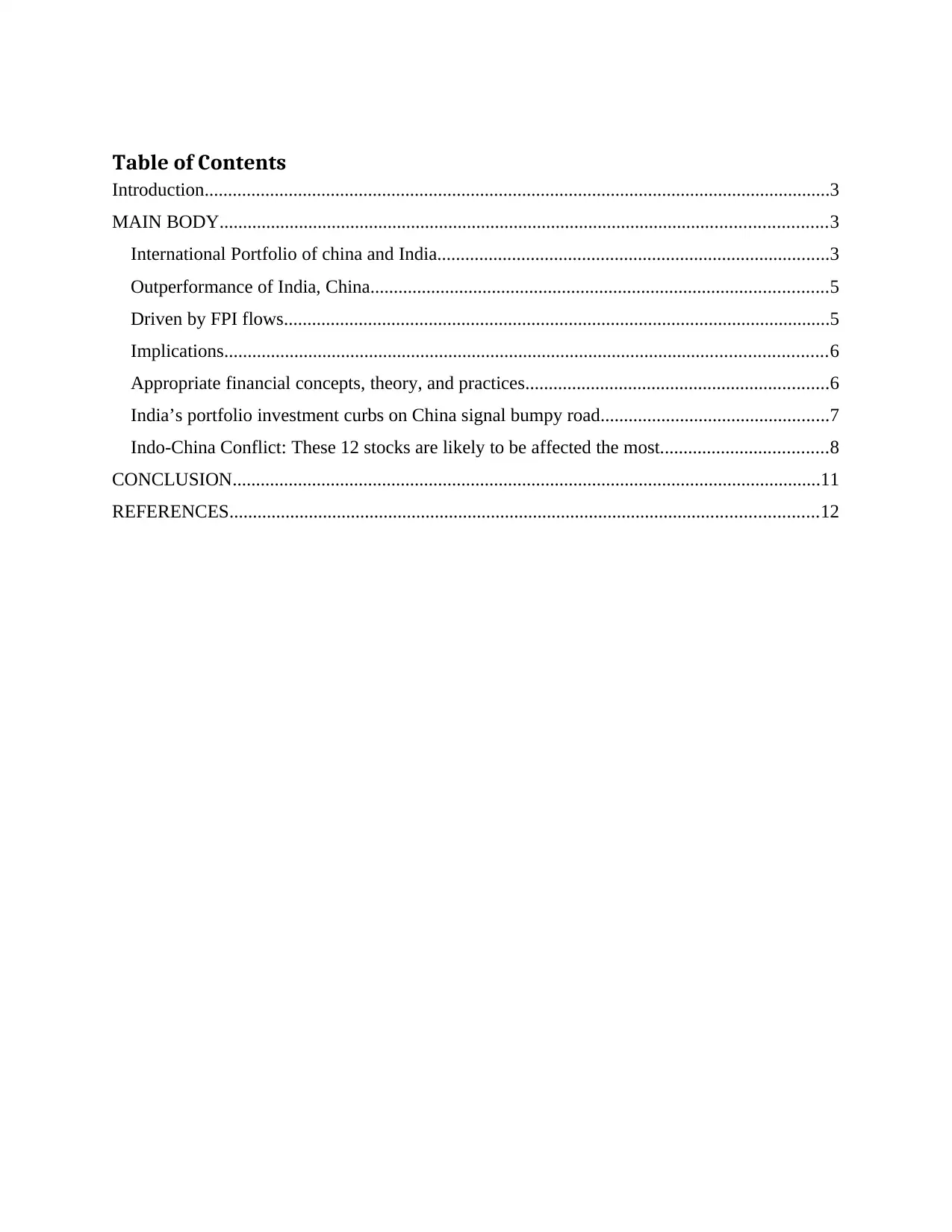
Table of Contents
Introduction......................................................................................................................................3
MAIN BODY..................................................................................................................................3
International Portfolio of china and India....................................................................................3
Outperformance of India, China..................................................................................................5
Driven by FPI flows.....................................................................................................................5
Implications.................................................................................................................................6
Appropriate financial concepts, theory, and practices.................................................................6
India’s portfolio investment curbs on China signal bumpy road.................................................7
Indo-China Conflict: These 12 stocks are likely to be affected the most....................................8
CONCLUSION..............................................................................................................................11
REFERENCES..............................................................................................................................12
Introduction......................................................................................................................................3
MAIN BODY..................................................................................................................................3
International Portfolio of china and India....................................................................................3
Outperformance of India, China..................................................................................................5
Driven by FPI flows.....................................................................................................................5
Implications.................................................................................................................................6
Appropriate financial concepts, theory, and practices.................................................................6
India’s portfolio investment curbs on China signal bumpy road.................................................7
Indo-China Conflict: These 12 stocks are likely to be affected the most....................................8
CONCLUSION..............................................................................................................................11
REFERENCES..............................................................................................................................12
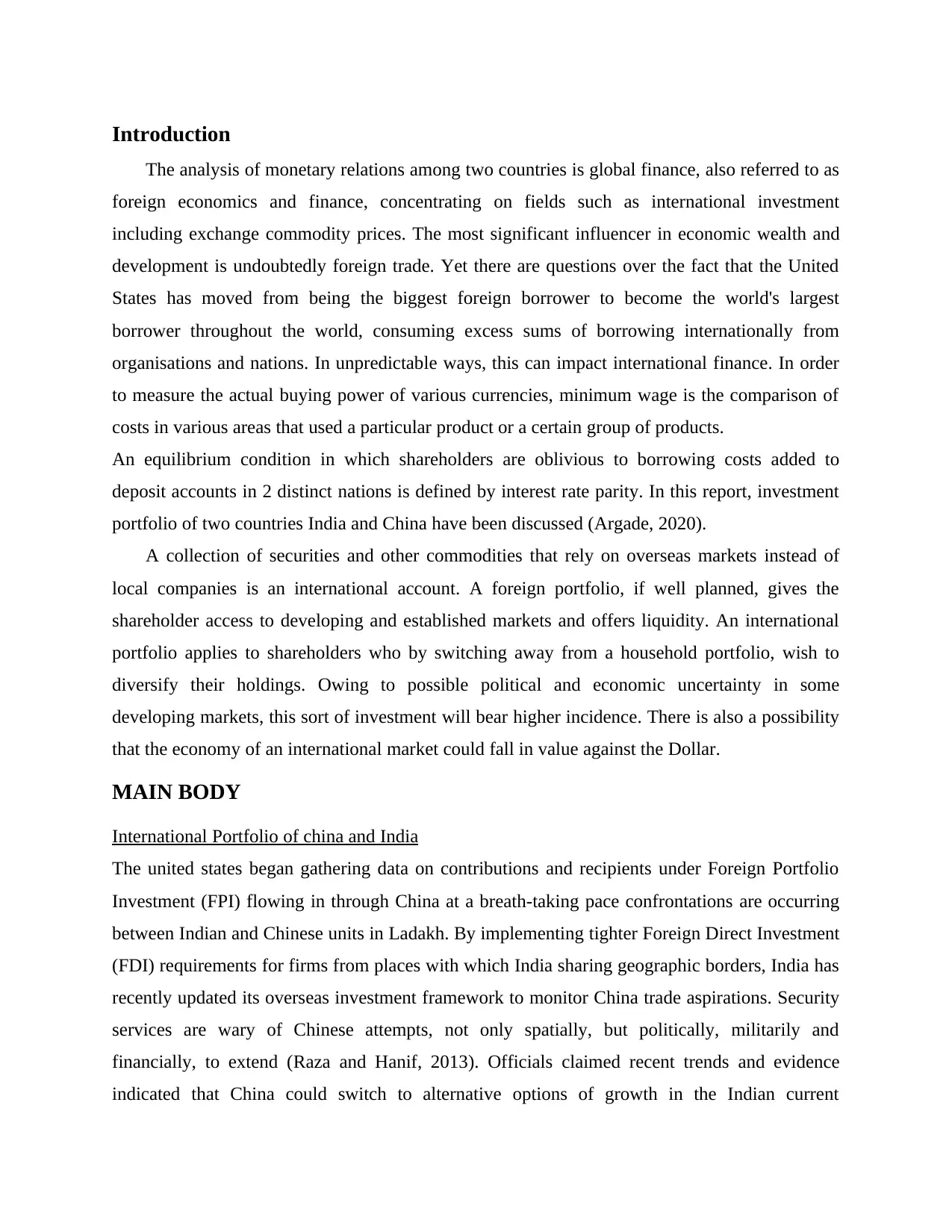
Introduction
The analysis of monetary relations among two countries is global finance, also referred to as
foreign economics and finance, concentrating on fields such as international investment
including exchange commodity prices. The most significant influencer in economic wealth and
development is undoubtedly foreign trade. Yet there are questions over the fact that the United
States has moved from being the biggest foreign borrower to become the world's largest
borrower throughout the world, consuming excess sums of borrowing internationally from
organisations and nations. In unpredictable ways, this can impact international finance. In order
to measure the actual buying power of various currencies, minimum wage is the comparison of
costs in various areas that used a particular product or a certain group of products.
An equilibrium condition in which shareholders are oblivious to borrowing costs added to
deposit accounts in 2 distinct nations is defined by interest rate parity. In this report, investment
portfolio of two countries India and China have been discussed (Argade, 2020).
A collection of securities and other commodities that rely on overseas markets instead of
local companies is an international account. A foreign portfolio, if well planned, gives the
shareholder access to developing and established markets and offers liquidity. An international
portfolio applies to shareholders who by switching away from a household portfolio, wish to
diversify their holdings. Owing to possible political and economic uncertainty in some
developing markets, this sort of investment will bear higher incidence. There is also a possibility
that the economy of an international market could fall in value against the Dollar.
MAIN BODY
International Portfolio of china and India
The united states began gathering data on contributions and recipients under Foreign Portfolio
Investment (FPI) flowing in through China at a breath-taking pace confrontations are occurring
between Indian and Chinese units in Ladakh. By implementing tighter Foreign Direct Investment
(FDI) requirements for firms from places with which India sharing geographic borders, India has
recently updated its overseas investment framework to monitor China trade aspirations. Security
services are wary of Chinese attempts, not only spatially, but politically, militarily and
financially, to extend (Raza and Hanif, 2013). Officials claimed recent trends and evidence
indicated that China could switch to alternative options of growth in the Indian current
The analysis of monetary relations among two countries is global finance, also referred to as
foreign economics and finance, concentrating on fields such as international investment
including exchange commodity prices. The most significant influencer in economic wealth and
development is undoubtedly foreign trade. Yet there are questions over the fact that the United
States has moved from being the biggest foreign borrower to become the world's largest
borrower throughout the world, consuming excess sums of borrowing internationally from
organisations and nations. In unpredictable ways, this can impact international finance. In order
to measure the actual buying power of various currencies, minimum wage is the comparison of
costs in various areas that used a particular product or a certain group of products.
An equilibrium condition in which shareholders are oblivious to borrowing costs added to
deposit accounts in 2 distinct nations is defined by interest rate parity. In this report, investment
portfolio of two countries India and China have been discussed (Argade, 2020).
A collection of securities and other commodities that rely on overseas markets instead of
local companies is an international account. A foreign portfolio, if well planned, gives the
shareholder access to developing and established markets and offers liquidity. An international
portfolio applies to shareholders who by switching away from a household portfolio, wish to
diversify their holdings. Owing to possible political and economic uncertainty in some
developing markets, this sort of investment will bear higher incidence. There is also a possibility
that the economy of an international market could fall in value against the Dollar.
MAIN BODY
International Portfolio of china and India
The united states began gathering data on contributions and recipients under Foreign Portfolio
Investment (FPI) flowing in through China at a breath-taking pace confrontations are occurring
between Indian and Chinese units in Ladakh. By implementing tighter Foreign Direct Investment
(FDI) requirements for firms from places with which India sharing geographic borders, India has
recently updated its overseas investment framework to monitor China trade aspirations. Security
services are wary of Chinese attempts, not only spatially, but politically, militarily and
financially, to extend (Raza and Hanif, 2013). Officials claimed recent trends and evidence
indicated that China could switch to alternative options of growth in the Indian current

macroeconomic control. China's latest way out is the FPI path, said a representative. With the
advent of the COVID-19 disease outbreak, intelligence researches have described those Chinese
investments by Foreign Investment Portfolio Asset Finance Capital expenditure the real amount
could be a lot higher than that one, a representative confirmed (Sarsby, 2016). The FPI path is
really the latest road out embraced by China,” said about an official. With the advent of the
COVID-19 disease outbreak, declassified documents revealed that somewhere between
December 2019 through March 2020, Chinese investment throughout NSE-listed firms by
International Portfolio Investments (FPI) grew many fold. The real amount might be a lot higher
than that one, an official confirmed. Together to, Foreign Institutional Investments (FIIs) as well
as Eligible Foreign Contributions (QFIs) are regarded as FPIs, which are among the interested
parties of the Indian capital market that play a key role in forming the current account deficit and
volatility. Current laws make it a requirement for businesses to appoint an investor even then for
a professional trader, the stake in the company reaches one per cent. References said it was for
Chinese FPI buyers, private banks may have been enticing destination as a majority of them will
have a significant number of unidentified FPIs with much less for one investment terms. Figures
available from intelligence services reveal that at most Rs 622,95 crore stocks are held by
anonymous overseas companies in 19 private banks. High levels of growth by unidentified
investors throughout the financial system, official does can contribute to a reversal of RBI's bank
consolidation and could contribute to some other event like Yes Bank's (Van Horen and
Claessens, 2012).
As per current laws, most transferable equities, like bonds, stocks, savings accounts, alternate
institutional investors (AIFs) and financial products, are eligible for FPI of India. Actually, SEBI
advent of the COVID-19 disease outbreak, intelligence researches have described those Chinese
investments by Foreign Investment Portfolio Asset Finance Capital expenditure the real amount
could be a lot higher than that one, a representative confirmed (Sarsby, 2016). The FPI path is
really the latest road out embraced by China,” said about an official. With the advent of the
COVID-19 disease outbreak, declassified documents revealed that somewhere between
December 2019 through March 2020, Chinese investment throughout NSE-listed firms by
International Portfolio Investments (FPI) grew many fold. The real amount might be a lot higher
than that one, an official confirmed. Together to, Foreign Institutional Investments (FIIs) as well
as Eligible Foreign Contributions (QFIs) are regarded as FPIs, which are among the interested
parties of the Indian capital market that play a key role in forming the current account deficit and
volatility. Current laws make it a requirement for businesses to appoint an investor even then for
a professional trader, the stake in the company reaches one per cent. References said it was for
Chinese FPI buyers, private banks may have been enticing destination as a majority of them will
have a significant number of unidentified FPIs with much less for one investment terms. Figures
available from intelligence services reveal that at most Rs 622,95 crore stocks are held by
anonymous overseas companies in 19 private banks. High levels of growth by unidentified
investors throughout the financial system, official does can contribute to a reversal of RBI's bank
consolidation and could contribute to some other event like Yes Bank's (Van Horen and
Claessens, 2012).
As per current laws, most transferable equities, like bonds, stocks, savings accounts, alternate
institutional investors (AIFs) and financial products, are eligible for FPI of India. Actually, SEBI
Secure Best Marks with AI Grader
Need help grading? Try our AI Grader for instant feedback on your assignments.
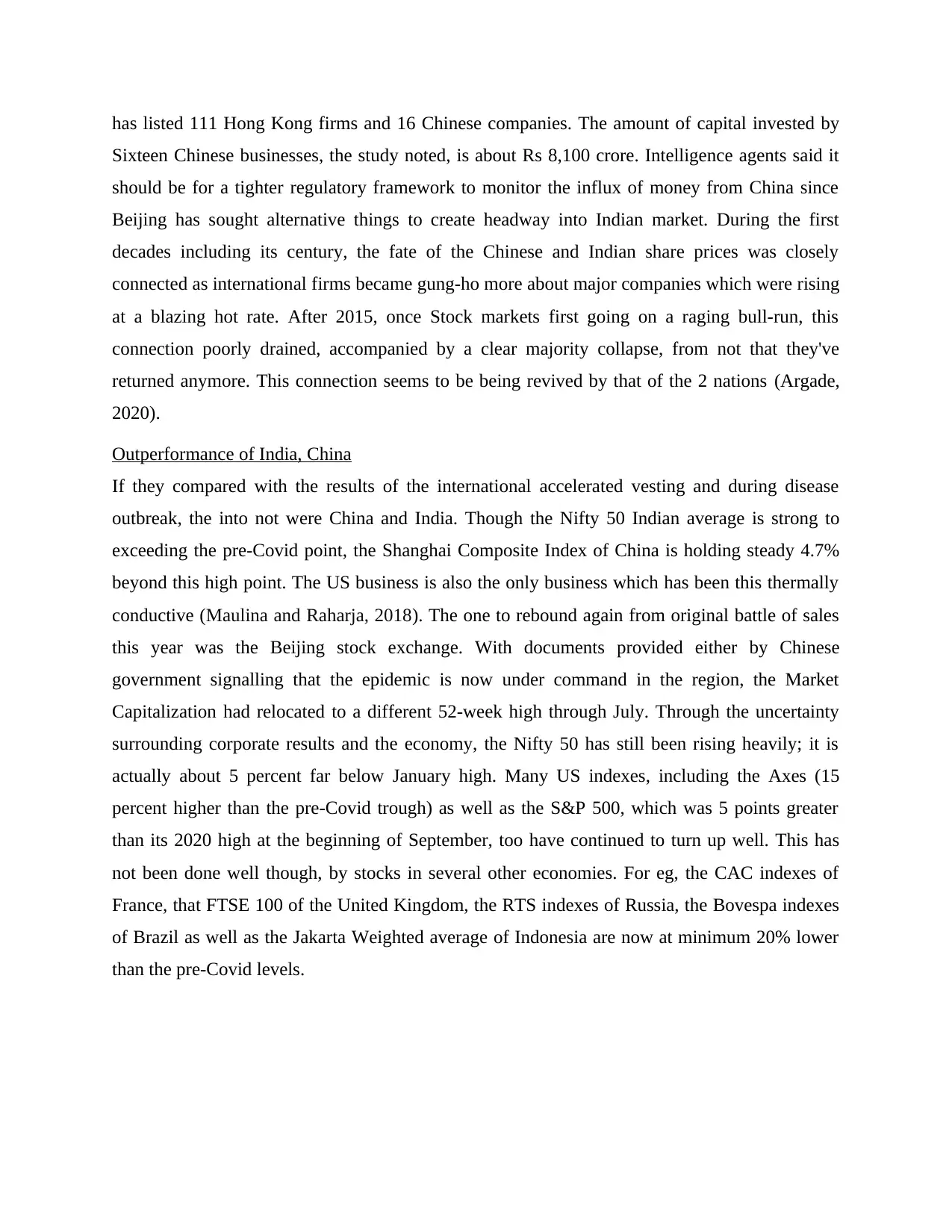
has listed 111 Hong Kong firms and 16 Chinese companies. The amount of capital invested by
Sixteen Chinese businesses, the study noted, is about Rs 8,100 crore. Intelligence agents said it
should be for a tighter regulatory framework to monitor the influx of money from China since
Beijing has sought alternative things to create headway into Indian market. During the first
decades including its century, the fate of the Chinese and Indian share prices was closely
connected as international firms became gung-ho more about major companies which were rising
at a blazing hot rate. After 2015, once Stock markets first going on a raging bull-run, this
connection poorly drained, accompanied by a clear majority collapse, from not that they've
returned anymore. This connection seems to be being revived by that of the 2 nations (Argade,
2020).
Outperformance of India, China
If they compared with the results of the international accelerated vesting and during disease
outbreak, the into not were China and India. Though the Nifty 50 Indian average is strong to
exceeding the pre-Covid point, the Shanghai Composite Index of China is holding steady 4.7%
beyond this high point. The US business is also the only business which has been this thermally
conductive (Maulina and Raharja, 2018). The one to rebound again from original battle of sales
this year was the Beijing stock exchange. With documents provided either by Chinese
government signalling that the epidemic is now under command in the region, the Market
Capitalization had relocated to a different 52-week high through July. Through the uncertainty
surrounding corporate results and the economy, the Nifty 50 has still been rising heavily; it is
actually about 5 percent far below January high. Many US indexes, including the Axes (15
percent higher than the pre-Covid trough) as well as the S&P 500, which was 5 points greater
than its 2020 high at the beginning of September, too have continued to turn up well. This has
not been done well though, by stocks in several other economies. For eg, the CAC indexes of
France, that FTSE 100 of the United Kingdom, the RTS indexes of Russia, the Bovespa indexes
of Brazil as well as the Jakarta Weighted average of Indonesia are now at minimum 20% lower
than the pre-Covid levels.
Sixteen Chinese businesses, the study noted, is about Rs 8,100 crore. Intelligence agents said it
should be for a tighter regulatory framework to monitor the influx of money from China since
Beijing has sought alternative things to create headway into Indian market. During the first
decades including its century, the fate of the Chinese and Indian share prices was closely
connected as international firms became gung-ho more about major companies which were rising
at a blazing hot rate. After 2015, once Stock markets first going on a raging bull-run, this
connection poorly drained, accompanied by a clear majority collapse, from not that they've
returned anymore. This connection seems to be being revived by that of the 2 nations (Argade,
2020).
Outperformance of India, China
If they compared with the results of the international accelerated vesting and during disease
outbreak, the into not were China and India. Though the Nifty 50 Indian average is strong to
exceeding the pre-Covid point, the Shanghai Composite Index of China is holding steady 4.7%
beyond this high point. The US business is also the only business which has been this thermally
conductive (Maulina and Raharja, 2018). The one to rebound again from original battle of sales
this year was the Beijing stock exchange. With documents provided either by Chinese
government signalling that the epidemic is now under command in the region, the Market
Capitalization had relocated to a different 52-week high through July. Through the uncertainty
surrounding corporate results and the economy, the Nifty 50 has still been rising heavily; it is
actually about 5 percent far below January high. Many US indexes, including the Axes (15
percent higher than the pre-Covid trough) as well as the S&P 500, which was 5 points greater
than its 2020 high at the beginning of September, too have continued to turn up well. This has
not been done well though, by stocks in several other economies. For eg, the CAC indexes of
France, that FTSE 100 of the United Kingdom, the RTS indexes of Russia, the Bovespa indexes
of Brazil as well as the Jakarta Weighted average of Indonesia are now at minimum 20% lower
than the pre-Covid levels.
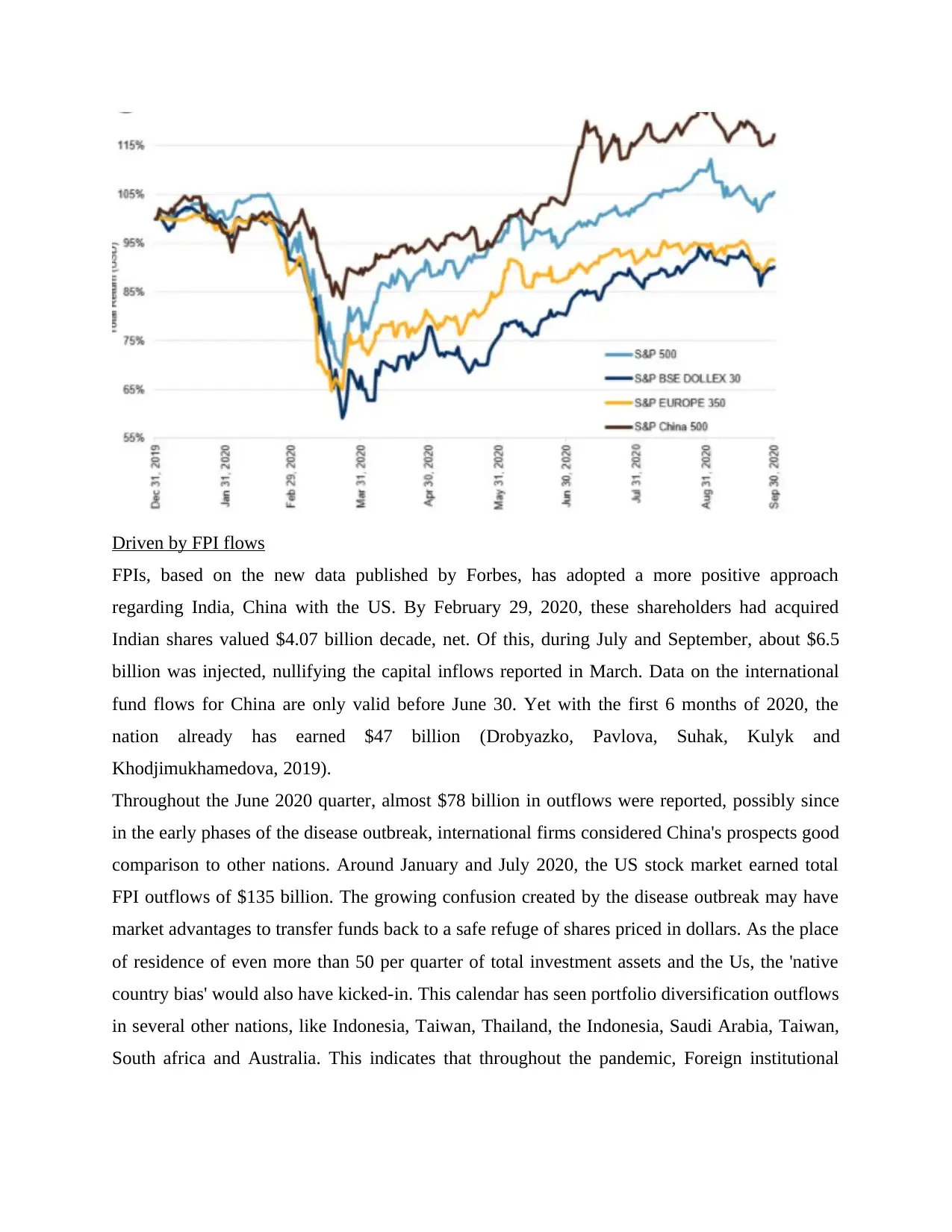
Driven by FPI flows
FPIs, based on the new data published by Forbes, has adopted a more positive approach
regarding India, China with the US. By February 29, 2020, these shareholders had acquired
Indian shares valued $4.07 billion decade, net. Of this, during July and September, about $6.5
billion was injected, nullifying the capital inflows reported in March. Data on the international
fund flows for China are only valid before June 30. Yet with the first 6 months of 2020, the
nation already has earned $47 billion (Drobyazko, Pavlova, Suhak, Kulyk and
Khodjimukhamedova, 2019).
Throughout the June 2020 quarter, almost $78 billion in outflows were reported, possibly since
in the early phases of the disease outbreak, international firms considered China's prospects good
comparison to other nations. Around January and July 2020, the US stock market earned total
FPI outflows of $135 billion. The growing confusion created by the disease outbreak may have
market advantages to transfer funds back to a safe refuge of shares priced in dollars. As the place
of residence of even more than 50 per quarter of total investment assets and the Us, the 'native
country bias' would also have kicked-in. This calendar has seen portfolio diversification outflows
in several other nations, like Indonesia, Taiwan, Thailand, the Indonesia, Saudi Arabia, Taiwan,
South africa and Australia. This indicates that throughout the pandemic, Foreign institutional
FPIs, based on the new data published by Forbes, has adopted a more positive approach
regarding India, China with the US. By February 29, 2020, these shareholders had acquired
Indian shares valued $4.07 billion decade, net. Of this, during July and September, about $6.5
billion was injected, nullifying the capital inflows reported in March. Data on the international
fund flows for China are only valid before June 30. Yet with the first 6 months of 2020, the
nation already has earned $47 billion (Drobyazko, Pavlova, Suhak, Kulyk and
Khodjimukhamedova, 2019).
Throughout the June 2020 quarter, almost $78 billion in outflows were reported, possibly since
in the early phases of the disease outbreak, international firms considered China's prospects good
comparison to other nations. Around January and July 2020, the US stock market earned total
FPI outflows of $135 billion. The growing confusion created by the disease outbreak may have
market advantages to transfer funds back to a safe refuge of shares priced in dollars. As the place
of residence of even more than 50 per quarter of total investment assets and the Us, the 'native
country bias' would also have kicked-in. This calendar has seen portfolio diversification outflows
in several other nations, like Indonesia, Taiwan, Thailand, the Indonesia, Saudi Arabia, Taiwan,
South africa and Australia. This indicates that throughout the pandemic, Foreign institutional

investors did not benefit all international economies. It seems that the response lies in the rate of
economic growth anticipated in the 2 nations (Tresidder and Hirst, 2012)
(Weiss, J. W., 2014). If the pandemic advanced and limits on travel persisted, updated estimates
of development grew bleaker. In all G-20 countries, the OECD forecasts GDP to expand around
3 and 12 billion in 2020. Global investor capital that has reached the financial markets isn't really
supposed to visit in a rush owing to the nation's comparatively inferior future growth. For many
of the early buyers who've had bunny on investment firms to navigate the boom over the recent
months, that's also positive news. It also suggests that price declines will not get very deep, if
there are any, as both international and domestic shareholders are ready to bet the cash on India
(Frame and White, 2014).
Implications
The only exception would be China, that is expected to expand this season by 1,8 percent.
Although the 2021 OECD forecasts indicate that while the rebound is projected to also be
lukewarm in certain nations, less than five percent are projected to surpass China and India.
Although China is estimated to rise by 8%, India is predicted to grow higher in 2021, at 10.7%.
This is well above the expected rise of 5% for both the planet and 5.7% for the members of the
G-20. It is quite likely that overseas firms are drawn by the quicker recovery throughout India
and China. In comparison, with a wide domestic demand market as well as a young generation
projected to rebound to the pre-Covid pace of operation sooner, the demographic benefit enjoyed
economic growth anticipated in the 2 nations (Tresidder and Hirst, 2012)
(Weiss, J. W., 2014). If the pandemic advanced and limits on travel persisted, updated estimates
of development grew bleaker. In all G-20 countries, the OECD forecasts GDP to expand around
3 and 12 billion in 2020. Global investor capital that has reached the financial markets isn't really
supposed to visit in a rush owing to the nation's comparatively inferior future growth. For many
of the early buyers who've had bunny on investment firms to navigate the boom over the recent
months, that's also positive news. It also suggests that price declines will not get very deep, if
there are any, as both international and domestic shareholders are ready to bet the cash on India
(Frame and White, 2014).
Implications
The only exception would be China, that is expected to expand this season by 1,8 percent.
Although the 2021 OECD forecasts indicate that while the rebound is projected to also be
lukewarm in certain nations, less than five percent are projected to surpass China and India.
Although China is estimated to rise by 8%, India is predicted to grow higher in 2021, at 10.7%.
This is well above the expected rise of 5% for both the planet and 5.7% for the members of the
G-20. It is quite likely that overseas firms are drawn by the quicker recovery throughout India
and China. In comparison, with a wide domestic demand market as well as a young generation
projected to rebound to the pre-Covid pace of operation sooner, the demographic benefit enjoyed
Paraphrase This Document
Need a fresh take? Get an instant paraphrase of this document with our AI Paraphraser
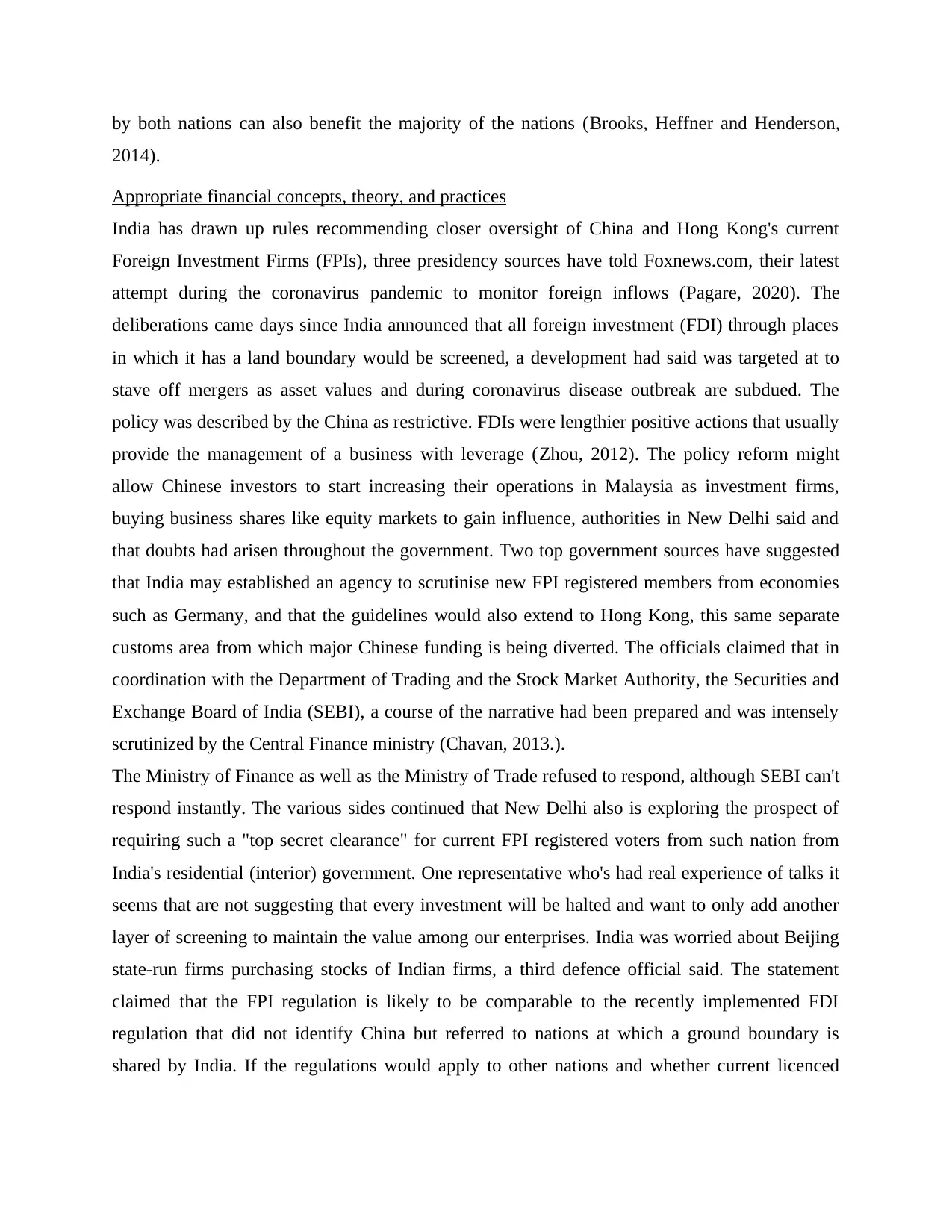
by both nations can also benefit the majority of the nations (Brooks, Heffner and Henderson,
2014).
Appropriate financial concepts, theory, and practices
India has drawn up rules recommending closer oversight of China and Hong Kong's current
Foreign Investment Firms (FPIs), three presidency sources have told Foxnews.com, their latest
attempt during the coronavirus pandemic to monitor foreign inflows (Pagare, 2020). The
deliberations came days since India announced that all foreign investment (FDI) through places
in which it has a land boundary would be screened, a development had said was targeted at to
stave off mergers as asset values and during coronavirus disease outbreak are subdued. The
policy was described by the China as restrictive. FDIs were lengthier positive actions that usually
provide the management of a business with leverage (Zhou, 2012). The policy reform might
allow Chinese investors to start increasing their operations in Malaysia as investment firms,
buying business shares like equity markets to gain influence, authorities in New Delhi said and
that doubts had arisen throughout the government. Two top government sources have suggested
that India may established an agency to scrutinise new FPI registered members from economies
such as Germany, and that the guidelines would also extend to Hong Kong, this same separate
customs area from which major Chinese funding is being diverted. The officials claimed that in
coordination with the Department of Trading and the Stock Market Authority, the Securities and
Exchange Board of India (SEBI), a course of the narrative had been prepared and was intensely
scrutinized by the Central Finance ministry (Chavan, 2013.).
The Ministry of Finance as well as the Ministry of Trade refused to respond, although SEBI can't
respond instantly. The various sides continued that New Delhi also is exploring the prospect of
requiring such a "top secret clearance" for current FPI registered voters from such nation from
India's residential (interior) government. One representative who's had real experience of talks it
seems that are not suggesting that every investment will be halted and want to only add another
layer of screening to maintain the value among our enterprises. India was worried about Beijing
state-run firms purchasing stocks of Indian firms, a third defence official said. The statement
claimed that the FPI regulation is likely to be comparable to the recently implemented FDI
regulation that did not identify China but referred to nations at which a ground boundary is
shared by India. If the regulations would apply to other nations and whether current licenced
2014).
Appropriate financial concepts, theory, and practices
India has drawn up rules recommending closer oversight of China and Hong Kong's current
Foreign Investment Firms (FPIs), three presidency sources have told Foxnews.com, their latest
attempt during the coronavirus pandemic to monitor foreign inflows (Pagare, 2020). The
deliberations came days since India announced that all foreign investment (FDI) through places
in which it has a land boundary would be screened, a development had said was targeted at to
stave off mergers as asset values and during coronavirus disease outbreak are subdued. The
policy was described by the China as restrictive. FDIs were lengthier positive actions that usually
provide the management of a business with leverage (Zhou, 2012). The policy reform might
allow Chinese investors to start increasing their operations in Malaysia as investment firms,
buying business shares like equity markets to gain influence, authorities in New Delhi said and
that doubts had arisen throughout the government. Two top government sources have suggested
that India may established an agency to scrutinise new FPI registered members from economies
such as Germany, and that the guidelines would also extend to Hong Kong, this same separate
customs area from which major Chinese funding is being diverted. The officials claimed that in
coordination with the Department of Trading and the Stock Market Authority, the Securities and
Exchange Board of India (SEBI), a course of the narrative had been prepared and was intensely
scrutinized by the Central Finance ministry (Chavan, 2013.).
The Ministry of Finance as well as the Ministry of Trade refused to respond, although SEBI can't
respond instantly. The various sides continued that New Delhi also is exploring the prospect of
requiring such a "top secret clearance" for current FPI registered voters from such nation from
India's residential (interior) government. One representative who's had real experience of talks it
seems that are not suggesting that every investment will be halted and want to only add another
layer of screening to maintain the value among our enterprises. India was worried about Beijing
state-run firms purchasing stocks of Indian firms, a third defence official said. The statement
claimed that the FPI regulation is likely to be comparable to the recently implemented FDI
regulation that did not identify China but referred to nations at which a ground boundary is
shared by India. If the regulations would apply to other nations and whether current licenced
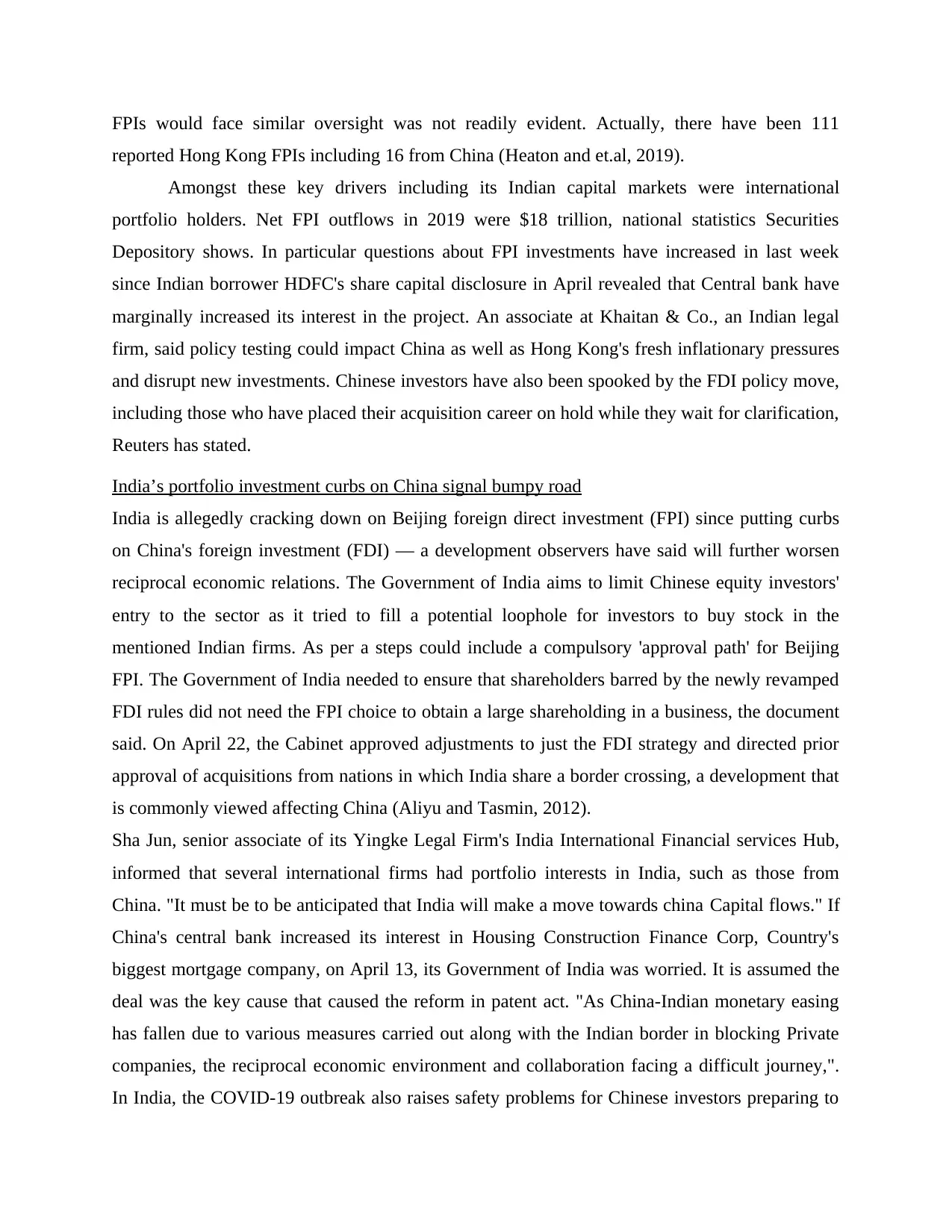
FPIs would face similar oversight was not readily evident. Actually, there have been 111
reported Hong Kong FPIs including 16 from China (Heaton and et.al, 2019).
Amongst these key drivers including its Indian capital markets were international
portfolio holders. Net FPI outflows in 2019 were $18 trillion, national statistics Securities
Depository shows. In particular questions about FPI investments have increased in last week
since Indian borrower HDFC's share capital disclosure in April revealed that Central bank have
marginally increased its interest in the project. An associate at Khaitan & Co., an Indian legal
firm, said policy testing could impact China as well as Hong Kong's fresh inflationary pressures
and disrupt new investments. Chinese investors have also been spooked by the FDI policy move,
including those who have placed their acquisition career on hold while they wait for clarification,
Reuters has stated.
India’s portfolio investment curbs on China signal bumpy road
India is allegedly cracking down on Beijing foreign direct investment (FPI) since putting curbs
on China's foreign investment (FDI) — a development observers have said will further worsen
reciprocal economic relations. The Government of India aims to limit Chinese equity investors'
entry to the sector as it tried to fill a potential loophole for investors to buy stock in the
mentioned Indian firms. As per a steps could include a compulsory 'approval path' for Beijing
FPI. The Government of India needed to ensure that shareholders barred by the newly revamped
FDI rules did not need the FPI choice to obtain a large shareholding in a business, the document
said. On April 22, the Cabinet approved adjustments to just the FDI strategy and directed prior
approval of acquisitions from nations in which India share a border crossing, a development that
is commonly viewed affecting China (Aliyu and Tasmin, 2012).
Sha Jun, senior associate of its Yingke Legal Firm's India International Financial services Hub,
informed that several international firms had portfolio interests in India, such as those from
China. "It must be to be anticipated that India will make a move towards china Capital flows." If
China's central bank increased its interest in Housing Construction Finance Corp, Country's
biggest mortgage company, on April 13, its Government of India was worried. It is assumed the
deal was the key cause that caused the reform in patent act. "As China-Indian monetary easing
has fallen due to various measures carried out along with the Indian border in blocking Private
companies, the reciprocal economic environment and collaboration facing a difficult journey,".
In India, the COVID-19 outbreak also raises safety problems for Chinese investors preparing to
reported Hong Kong FPIs including 16 from China (Heaton and et.al, 2019).
Amongst these key drivers including its Indian capital markets were international
portfolio holders. Net FPI outflows in 2019 were $18 trillion, national statistics Securities
Depository shows. In particular questions about FPI investments have increased in last week
since Indian borrower HDFC's share capital disclosure in April revealed that Central bank have
marginally increased its interest in the project. An associate at Khaitan & Co., an Indian legal
firm, said policy testing could impact China as well as Hong Kong's fresh inflationary pressures
and disrupt new investments. Chinese investors have also been spooked by the FDI policy move,
including those who have placed their acquisition career on hold while they wait for clarification,
Reuters has stated.
India’s portfolio investment curbs on China signal bumpy road
India is allegedly cracking down on Beijing foreign direct investment (FPI) since putting curbs
on China's foreign investment (FDI) — a development observers have said will further worsen
reciprocal economic relations. The Government of India aims to limit Chinese equity investors'
entry to the sector as it tried to fill a potential loophole for investors to buy stock in the
mentioned Indian firms. As per a steps could include a compulsory 'approval path' for Beijing
FPI. The Government of India needed to ensure that shareholders barred by the newly revamped
FDI rules did not need the FPI choice to obtain a large shareholding in a business, the document
said. On April 22, the Cabinet approved adjustments to just the FDI strategy and directed prior
approval of acquisitions from nations in which India share a border crossing, a development that
is commonly viewed affecting China (Aliyu and Tasmin, 2012).
Sha Jun, senior associate of its Yingke Legal Firm's India International Financial services Hub,
informed that several international firms had portfolio interests in India, such as those from
China. "It must be to be anticipated that India will make a move towards china Capital flows." If
China's central bank increased its interest in Housing Construction Finance Corp, Country's
biggest mortgage company, on April 13, its Government of India was worried. It is assumed the
deal was the key cause that caused the reform in patent act. "As China-Indian monetary easing
has fallen due to various measures carried out along with the Indian border in blocking Private
companies, the reciprocal economic environment and collaboration facing a difficult journey,".
In India, the COVID-19 outbreak also raises safety problems for Chinese investors preparing to

go on work trips to India. After the launching of the national FDI policy, Chinese policy of India
disappeared, a fast reversal compared to the growing excitement of investors last year. A Chinese
consultancy company is based on Indian financial products in recent time. Information from of
the Consulate General in India revealed as of December 2019, China's combined policy of India
have surpassed $8 billion, significantly more than the building support from many other nations
that share borders towards India. Due to the instability of Indian policy decisions as well as the
perception that Indian policy are affected by certain Western nations, especially the US, which
are restricting Private companies, many Chinese investors take a buy and hold approach (Tarpani
and Azapagic, 2018).
Indo-China Conflict: These 12 stocks are likely to be affected the most.
Political and economic concerns among India and China have been exacerbated by the latest
border dispute with China throughout the Galwan Region of Ladakh. Viewpoints throughout
India are rising clearer to reject Chinese goods across categories. Throughout terms of
procurement, sectors such as vehicles, consumer goods, medical devices, telecommunications,
pesticides and green energy (solar) have been most important to China. In certain cases, there is a
shortage of different sources at the very same size or expense. Although luxury goods rely on
China for parts, pharmaceuticals rely on API procurement (Awais and Samin, 2012). Mobile
Phone Company depends on China to networking gear and also 4G cellular phones, as China
meets upwards of 75% of India's request for devices. Vodafone as well as Bharti Airtel will
become the most impacted in the telecommunications domain in the event of tariff and
production bollards on suppliers of telecommunications networking gear (Verma and et.al.,
2014). It was of the opinion that throughout the present climate, any possible confrontation
between both the two countries may raise risk exposures, even when economies are looking to
rebound from the disease outbreak. Overall, it'd be expensive and time consuming for Indian
companies to find affordable instantly, it added. In the chemical room, stocks such as internal
network India, Dhanuka, Sumitomo India, as well as Insecticide Malaysia could have a greater
effect. A lower effect on PI Sectors, UPL, Identifying a potential, and Bayer can be seen. Info
Advantage will be influenced in the e-commerce field as its investor firms, Zomato but Policy
Bazaar, are exposed to China's investments (Nguyen, 2016). Chinese firms have major
investments among Indian software and e-commerce companies such as Byju, Paytm, Swiggy,
Ola, BigBasket and Snapdeal.
disappeared, a fast reversal compared to the growing excitement of investors last year. A Chinese
consultancy company is based on Indian financial products in recent time. Information from of
the Consulate General in India revealed as of December 2019, China's combined policy of India
have surpassed $8 billion, significantly more than the building support from many other nations
that share borders towards India. Due to the instability of Indian policy decisions as well as the
perception that Indian policy are affected by certain Western nations, especially the US, which
are restricting Private companies, many Chinese investors take a buy and hold approach (Tarpani
and Azapagic, 2018).
Indo-China Conflict: These 12 stocks are likely to be affected the most.
Political and economic concerns among India and China have been exacerbated by the latest
border dispute with China throughout the Galwan Region of Ladakh. Viewpoints throughout
India are rising clearer to reject Chinese goods across categories. Throughout terms of
procurement, sectors such as vehicles, consumer goods, medical devices, telecommunications,
pesticides and green energy (solar) have been most important to China. In certain cases, there is a
shortage of different sources at the very same size or expense. Although luxury goods rely on
China for parts, pharmaceuticals rely on API procurement (Awais and Samin, 2012). Mobile
Phone Company depends on China to networking gear and also 4G cellular phones, as China
meets upwards of 75% of India's request for devices. Vodafone as well as Bharti Airtel will
become the most impacted in the telecommunications domain in the event of tariff and
production bollards on suppliers of telecommunications networking gear (Verma and et.al.,
2014). It was of the opinion that throughout the present climate, any possible confrontation
between both the two countries may raise risk exposures, even when economies are looking to
rebound from the disease outbreak. Overall, it'd be expensive and time consuming for Indian
companies to find affordable instantly, it added. In the chemical room, stocks such as internal
network India, Dhanuka, Sumitomo India, as well as Insecticide Malaysia could have a greater
effect. A lower effect on PI Sectors, UPL, Identifying a potential, and Bayer can be seen. Info
Advantage will be influenced in the e-commerce field as its investor firms, Zomato but Policy
Bazaar, are exposed to China's investments (Nguyen, 2016). Chinese firms have major
investments among Indian software and e-commerce companies such as Byju, Paytm, Swiggy,
Ola, BigBasket and Snapdeal.
Secure Best Marks with AI Grader
Need help grading? Try our AI Grader for instant feedback on your assignments.
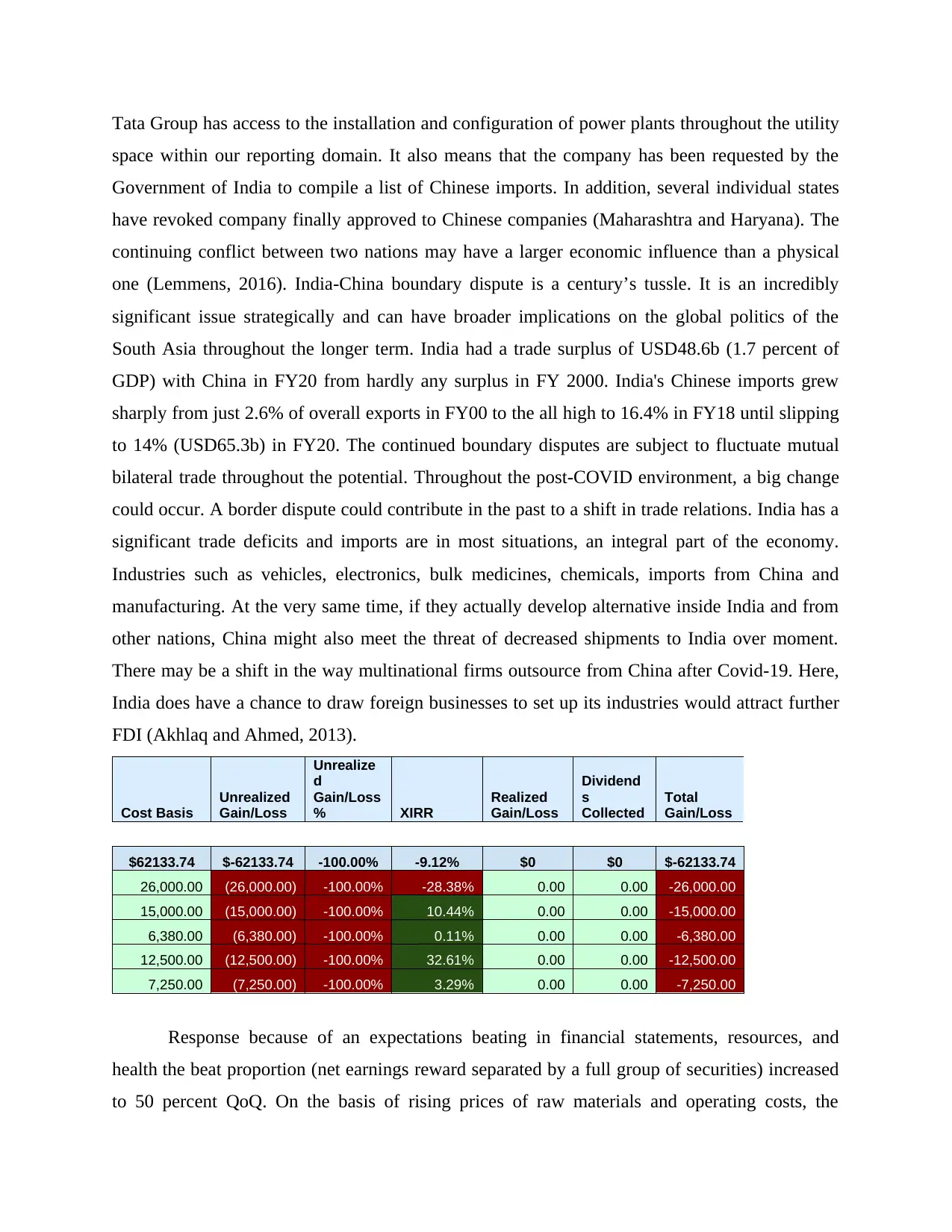
Tata Group has access to the installation and configuration of power plants throughout the utility
space within our reporting domain. It also means that the company has been requested by the
Government of India to compile a list of Chinese imports. In addition, several individual states
have revoked company finally approved to Chinese companies (Maharashtra and Haryana). The
continuing conflict between two nations may have a larger economic influence than a physical
one (Lemmens, 2016). India-China boundary dispute is a century’s tussle. It is an incredibly
significant issue strategically and can have broader implications on the global politics of the
South Asia throughout the longer term. India had a trade surplus of USD48.6b (1.7 percent of
GDP) with China in FY20 from hardly any surplus in FY 2000. India's Chinese imports grew
sharply from just 2.6% of overall exports in FY00 to the all high to 16.4% in FY18 until slipping
to 14% (USD65.3b) in FY20. The continued boundary disputes are subject to fluctuate mutual
bilateral trade throughout the potential. Throughout the post-COVID environment, a big change
could occur. A border dispute could contribute in the past to a shift in trade relations. India has a
significant trade deficits and imports are in most situations, an integral part of the economy.
Industries such as vehicles, electronics, bulk medicines, chemicals, imports from China and
manufacturing. At the very same time, if they actually develop alternative inside India and from
other nations, China might also meet the threat of decreased shipments to India over moment.
There may be a shift in the way multinational firms outsource from China after Covid-19. Here,
India does have a chance to draw foreign businesses to set up its industries would attract further
FDI (Akhlaq and Ahmed, 2013).
Cost Basis
Unrealized
Gain/Loss
Unrealize
d
Gain/Loss
% XIRR
Realized
Gain/Loss
Dividend
s
Collected
Total
Gain/Loss
$62133.74 $-62133.74 -100.00% -9.12% $0 $0 $-62133.74
26,000.00 (26,000.00) -100.00% -28.38% 0.00 0.00 -26,000.00
15,000.00 (15,000.00) -100.00% 10.44% 0.00 0.00 -15,000.00
6,380.00 (6,380.00) -100.00% 0.11% 0.00 0.00 -6,380.00
12,500.00 (12,500.00) -100.00% 32.61% 0.00 0.00 -12,500.00
7,250.00 (7,250.00) -100.00% 3.29% 0.00 0.00 -7,250.00
Response because of an expectations beating in financial statements, resources, and
health the beat proportion (net earnings reward separated by a full group of securities) increased
to 50 percent QoQ. On the basis of rising prices of raw materials and operating costs, the
space within our reporting domain. It also means that the company has been requested by the
Government of India to compile a list of Chinese imports. In addition, several individual states
have revoked company finally approved to Chinese companies (Maharashtra and Haryana). The
continuing conflict between two nations may have a larger economic influence than a physical
one (Lemmens, 2016). India-China boundary dispute is a century’s tussle. It is an incredibly
significant issue strategically and can have broader implications on the global politics of the
South Asia throughout the longer term. India had a trade surplus of USD48.6b (1.7 percent of
GDP) with China in FY20 from hardly any surplus in FY 2000. India's Chinese imports grew
sharply from just 2.6% of overall exports in FY00 to the all high to 16.4% in FY18 until slipping
to 14% (USD65.3b) in FY20. The continued boundary disputes are subject to fluctuate mutual
bilateral trade throughout the potential. Throughout the post-COVID environment, a big change
could occur. A border dispute could contribute in the past to a shift in trade relations. India has a
significant trade deficits and imports are in most situations, an integral part of the economy.
Industries such as vehicles, electronics, bulk medicines, chemicals, imports from China and
manufacturing. At the very same time, if they actually develop alternative inside India and from
other nations, China might also meet the threat of decreased shipments to India over moment.
There may be a shift in the way multinational firms outsource from China after Covid-19. Here,
India does have a chance to draw foreign businesses to set up its industries would attract further
FDI (Akhlaq and Ahmed, 2013).
Cost Basis
Unrealized
Gain/Loss
Unrealize
d
Gain/Loss
% XIRR
Realized
Gain/Loss
Dividend
s
Collected
Total
Gain/Loss
$62133.74 $-62133.74 -100.00% -9.12% $0 $0 $-62133.74
26,000.00 (26,000.00) -100.00% -28.38% 0.00 0.00 -26,000.00
15,000.00 (15,000.00) -100.00% 10.44% 0.00 0.00 -15,000.00
6,380.00 (6,380.00) -100.00% 0.11% 0.00 0.00 -6,380.00
12,500.00 (12,500.00) -100.00% 32.61% 0.00 0.00 -12,500.00
7,250.00 (7,250.00) -100.00% 3.29% 0.00 0.00 -7,250.00
Response because of an expectations beating in financial statements, resources, and
health the beat proportion (net earnings reward separated by a full group of securities) increased
to 50 percent QoQ. On the basis of rising prices of raw materials and operating costs, the
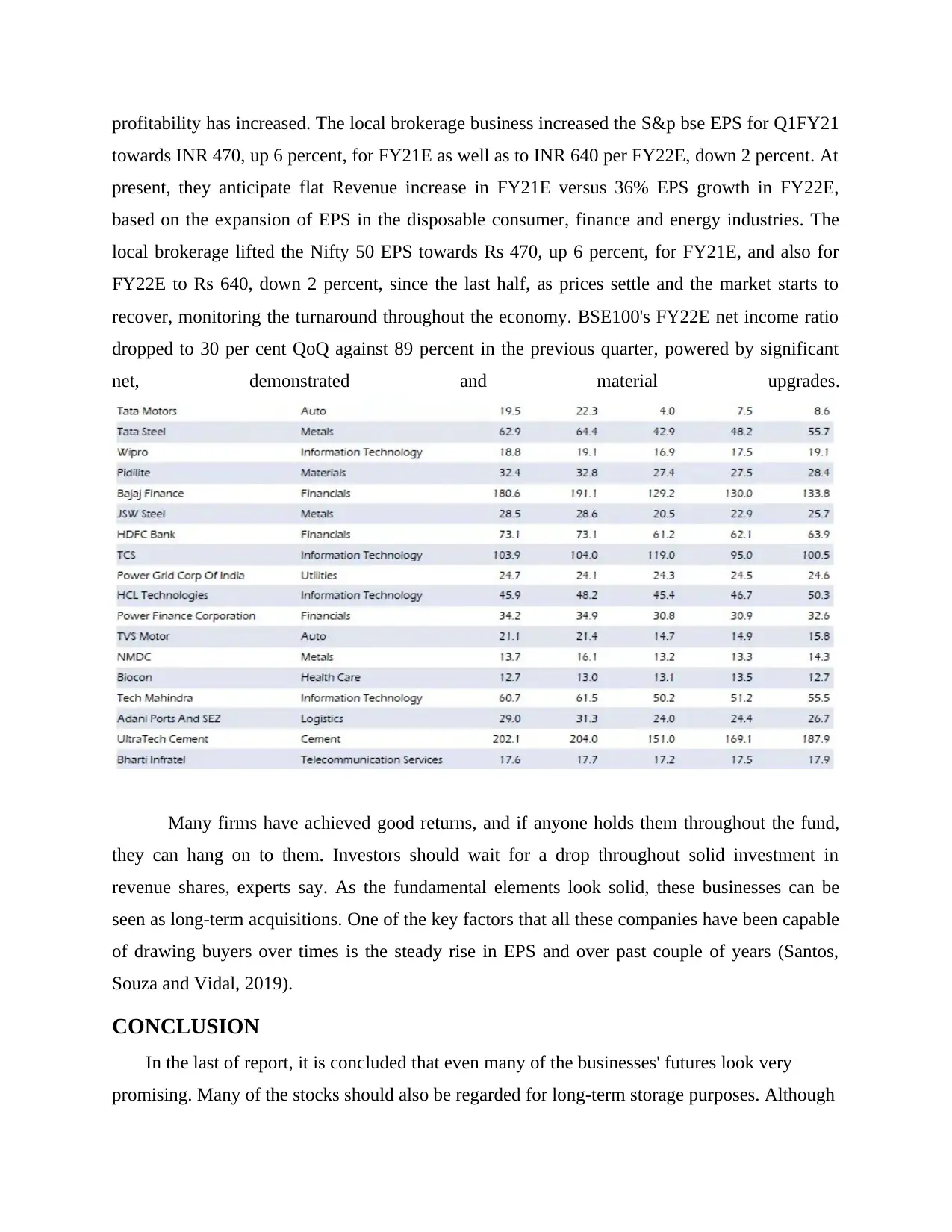
profitability has increased. The local brokerage business increased the S&p bse EPS for Q1FY21
towards INR 470, up 6 percent, for FY21E as well as to INR 640 per FY22E, down 2 percent. At
present, they anticipate flat Revenue increase in FY21E versus 36% EPS growth in FY22E,
based on the expansion of EPS in the disposable consumer, finance and energy industries. The
local brokerage lifted the Nifty 50 EPS towards Rs 470, up 6 percent, for FY21E, and also for
FY22E to Rs 640, down 2 percent, since the last half, as prices settle and the market starts to
recover, monitoring the turnaround throughout the economy. BSE100's FY22E net income ratio
dropped to 30 per cent QoQ against 89 percent in the previous quarter, powered by significant
net, demonstrated and material upgrades.
Many firms have achieved good returns, and if anyone holds them throughout the fund,
they can hang on to them. Investors should wait for a drop throughout solid investment in
revenue shares, experts say. As the fundamental elements look solid, these businesses can be
seen as long-term acquisitions. One of the key factors that all these companies have been capable
of drawing buyers over times is the steady rise in EPS and over past couple of years (Santos,
Souza and Vidal, 2019).
CONCLUSION
In the last of report, it is concluded that even many of the businesses' futures look very
promising. Many of the stocks should also be regarded for long-term storage purposes. Although
towards INR 470, up 6 percent, for FY21E as well as to INR 640 per FY22E, down 2 percent. At
present, they anticipate flat Revenue increase in FY21E versus 36% EPS growth in FY22E,
based on the expansion of EPS in the disposable consumer, finance and energy industries. The
local brokerage lifted the Nifty 50 EPS towards Rs 470, up 6 percent, for FY21E, and also for
FY22E to Rs 640, down 2 percent, since the last half, as prices settle and the market starts to
recover, monitoring the turnaround throughout the economy. BSE100's FY22E net income ratio
dropped to 30 per cent QoQ against 89 percent in the previous quarter, powered by significant
net, demonstrated and material upgrades.
Many firms have achieved good returns, and if anyone holds them throughout the fund,
they can hang on to them. Investors should wait for a drop throughout solid investment in
revenue shares, experts say. As the fundamental elements look solid, these businesses can be
seen as long-term acquisitions. One of the key factors that all these companies have been capable
of drawing buyers over times is the steady rise in EPS and over past couple of years (Santos,
Souza and Vidal, 2019).
CONCLUSION
In the last of report, it is concluded that even many of the businesses' futures look very
promising. Many of the stocks should also be regarded for long-term storage purposes. Although
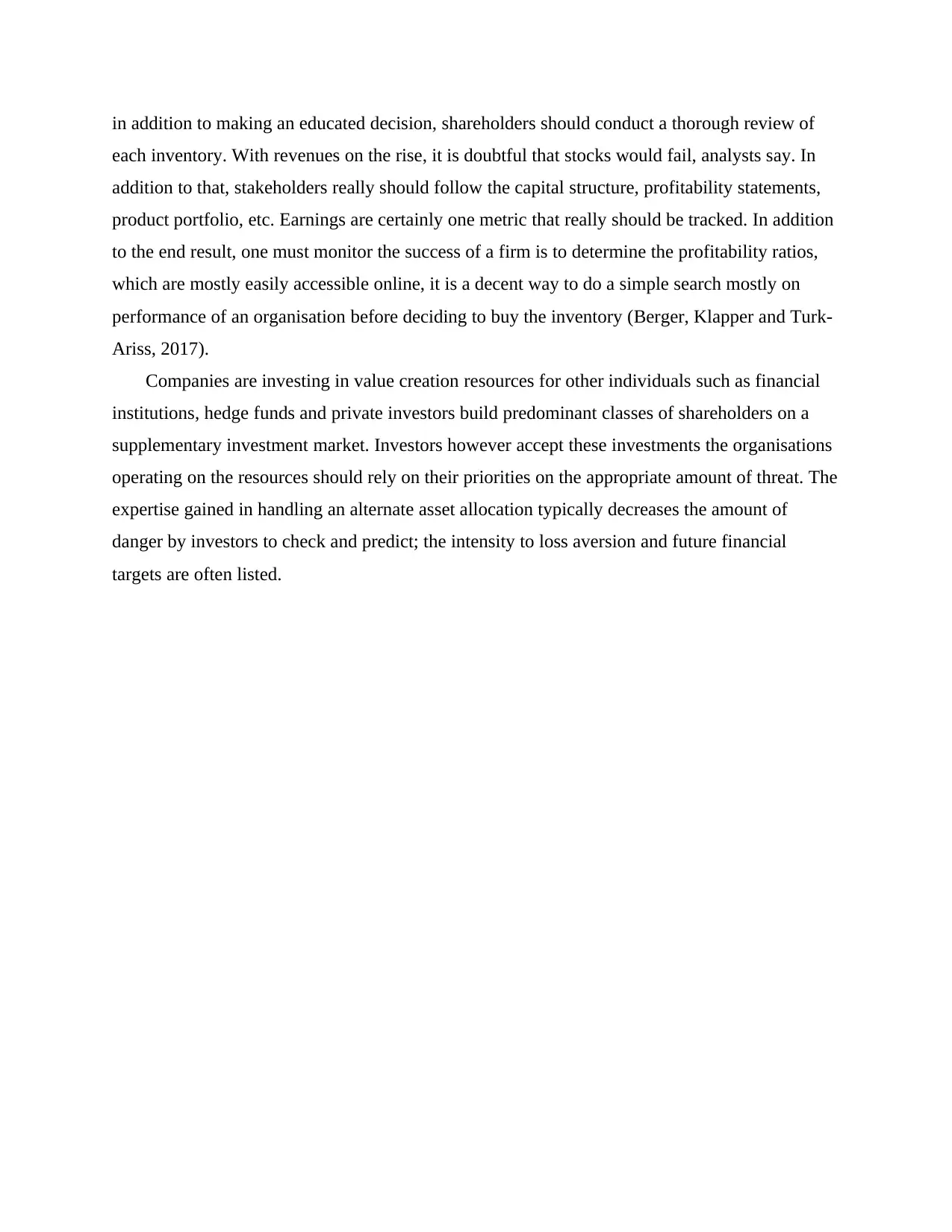
in addition to making an educated decision, shareholders should conduct a thorough review of
each inventory. With revenues on the rise, it is doubtful that stocks would fail, analysts say. In
addition to that, stakeholders really should follow the capital structure, profitability statements,
product portfolio, etc. Earnings are certainly one metric that really should be tracked. In addition
to the end result, one must monitor the success of a firm is to determine the profitability ratios,
which are mostly easily accessible online, it is a decent way to do a simple search mostly on
performance of an organisation before deciding to buy the inventory (Berger, Klapper and Turk-
Ariss, 2017).
Companies are investing in value creation resources for other individuals such as financial
institutions, hedge funds and private investors build predominant classes of shareholders on a
supplementary investment market. Investors however accept these investments the organisations
operating on the resources should rely on their priorities on the appropriate amount of threat. The
expertise gained in handling an alternate asset allocation typically decreases the amount of
danger by investors to check and predict; the intensity to loss aversion and future financial
targets are often listed.
each inventory. With revenues on the rise, it is doubtful that stocks would fail, analysts say. In
addition to that, stakeholders really should follow the capital structure, profitability statements,
product portfolio, etc. Earnings are certainly one metric that really should be tracked. In addition
to the end result, one must monitor the success of a firm is to determine the profitability ratios,
which are mostly easily accessible online, it is a decent way to do a simple search mostly on
performance of an organisation before deciding to buy the inventory (Berger, Klapper and Turk-
Ariss, 2017).
Companies are investing in value creation resources for other individuals such as financial
institutions, hedge funds and private investors build predominant classes of shareholders on a
supplementary investment market. Investors however accept these investments the organisations
operating on the resources should rely on their priorities on the appropriate amount of threat. The
expertise gained in handling an alternate asset allocation typically decreases the amount of
danger by investors to check and predict; the intensity to loss aversion and future financial
targets are often listed.
Paraphrase This Document
Need a fresh take? Get an instant paraphrase of this document with our AI Paraphraser

REFERENCES
Books and Journals
Akhlaq, A. and Ahmed, E., 2013. The effect of motivation on trust in the acceptance of internet
banking in a low income country. International journal of bank marketing.
Aliyu, A. A. and Tasmin, R. B. H. J., 2012. The impact of information and communication
technology on banks’ performance and customer service delivery in the banking
industry. International Journal of latest trends finance and economy, 2(1), pp.80-90.
Argade, S. L., 2020. Contract Costing: Meaning, Definitions, Contract Costing concepts.
Argade, S. L., 2020. Job Costing.
Berger, A. N., Klapper, L. F. and Turk-Ariss, R., 2017. Bank competition and financial stability.
In Handbook of Competition in Banking and Finance. Edward Elgar Publishing.
Chavan, J., 2013. Internet banking-benefits and challenges in an emerging
economy. International Journal of Research in Business Management, 1(1), pp.19-26.
Drobyazko, S., Pavlova, H., Suhak, T., Kulyk, V. and Khodjimukhamedova, S., 2019. Formation
of hybrid costing system accounting model at the enterprise.
Frame, W. S. and White, L. J., 2014. Technological change, financial innovation, and diffusion
in banking (pp. 1-5). Leonard N. Stern School of Business, Department of Economics.
Heaton, H.A., and et.al, 2019. A time-driven activity-based costing analysis of emergency
department scribes. Mayo Clinic Proceedings: Innovations, Quality & Outcomes, 3(1),
pp.30-34.
Lemmens, S., 2016. Cost engineering techniques and their applicability for cost estimation of
organic Rankine cycle systems. Energies, 9(7), p.485.
Nguyen, Q. K., 2016, November. Blockchain-a financial technology for future sustainable
development. In 2016 3rd International conference on green technology and sustainable
development (GTSD) (pp. 51-54). IEEE.
Pagare, S., 2020. Chapter-1: Basics of Cost Accounting-MCQ.
Raza, S. A. and Hanif, N., 2013. Factors affecting internet banking adoption among internal and
external customers: a case of Pakistan. International Journal of Electronic Finance, 7(1),
pp.82-96.
Santos, C.A.D.A.L., Souza, A.I. and Vidal, S.A., 2019. Techniques for determining the treatment
costs of cervical cancer: A systematic review. Open Journal of Obstetrics and
Gynecology, 9(2), pp.117-128.
Tarpani, R. R. Z. and Azapagic, A., 2018. Life cycle costs of advanced treatment techniques for
wastewater reuse and resource recovery from sewage sludge. Journal of Cleaner
Production, 204, pp.832-847.
Van Horen, N. and Claessens, S., 2012. Foreign banks: Trends, impact and financial stability.
International Monetary Fund.
Zhou, T., 2012. Examining mobile banking user adoption from the perspectives of trust and flow
experience. Information Technology and Management, 13(1), pp.27-37.
Awais, M. and Samin, T., 2012. Advanced SWOT Analysis of E-commerce. International
Journal of Computer Science Issues (IJCSI), 9(2), p.569.
Brooks, G., Heffner, A. and Henderson, D., 2014. A SWOT analysis of competitive knowledge
from social media for a small start-up business. Review of Business Information Systems
(RBIS), 18(1), pp.23-34.
Books and Journals
Akhlaq, A. and Ahmed, E., 2013. The effect of motivation on trust in the acceptance of internet
banking in a low income country. International journal of bank marketing.
Aliyu, A. A. and Tasmin, R. B. H. J., 2012. The impact of information and communication
technology on banks’ performance and customer service delivery in the banking
industry. International Journal of latest trends finance and economy, 2(1), pp.80-90.
Argade, S. L., 2020. Contract Costing: Meaning, Definitions, Contract Costing concepts.
Argade, S. L., 2020. Job Costing.
Berger, A. N., Klapper, L. F. and Turk-Ariss, R., 2017. Bank competition and financial stability.
In Handbook of Competition in Banking and Finance. Edward Elgar Publishing.
Chavan, J., 2013. Internet banking-benefits and challenges in an emerging
economy. International Journal of Research in Business Management, 1(1), pp.19-26.
Drobyazko, S., Pavlova, H., Suhak, T., Kulyk, V. and Khodjimukhamedova, S., 2019. Formation
of hybrid costing system accounting model at the enterprise.
Frame, W. S. and White, L. J., 2014. Technological change, financial innovation, and diffusion
in banking (pp. 1-5). Leonard N. Stern School of Business, Department of Economics.
Heaton, H.A., and et.al, 2019. A time-driven activity-based costing analysis of emergency
department scribes. Mayo Clinic Proceedings: Innovations, Quality & Outcomes, 3(1),
pp.30-34.
Lemmens, S., 2016. Cost engineering techniques and their applicability for cost estimation of
organic Rankine cycle systems. Energies, 9(7), p.485.
Nguyen, Q. K., 2016, November. Blockchain-a financial technology for future sustainable
development. In 2016 3rd International conference on green technology and sustainable
development (GTSD) (pp. 51-54). IEEE.
Pagare, S., 2020. Chapter-1: Basics of Cost Accounting-MCQ.
Raza, S. A. and Hanif, N., 2013. Factors affecting internet banking adoption among internal and
external customers: a case of Pakistan. International Journal of Electronic Finance, 7(1),
pp.82-96.
Santos, C.A.D.A.L., Souza, A.I. and Vidal, S.A., 2019. Techniques for determining the treatment
costs of cervical cancer: A systematic review. Open Journal of Obstetrics and
Gynecology, 9(2), pp.117-128.
Tarpani, R. R. Z. and Azapagic, A., 2018. Life cycle costs of advanced treatment techniques for
wastewater reuse and resource recovery from sewage sludge. Journal of Cleaner
Production, 204, pp.832-847.
Van Horen, N. and Claessens, S., 2012. Foreign banks: Trends, impact and financial stability.
International Monetary Fund.
Zhou, T., 2012. Examining mobile banking user adoption from the perspectives of trust and flow
experience. Information Technology and Management, 13(1), pp.27-37.
Awais, M. and Samin, T., 2012. Advanced SWOT Analysis of E-commerce. International
Journal of Computer Science Issues (IJCSI), 9(2), p.569.
Brooks, G., Heffner, A. and Henderson, D., 2014. A SWOT analysis of competitive knowledge
from social media for a small start-up business. Review of Business Information Systems
(RBIS), 18(1), pp.23-34.
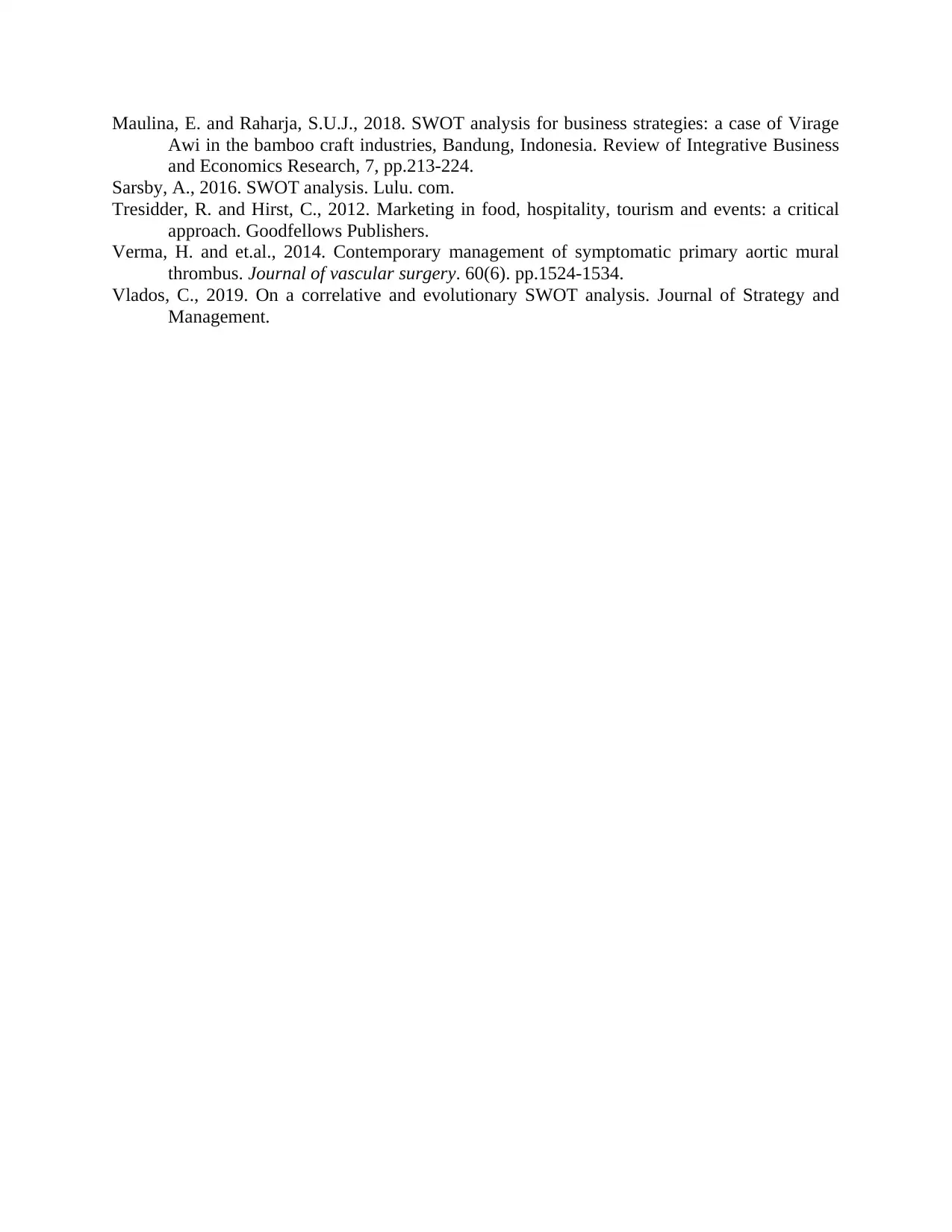
Maulina, E. and Raharja, S.U.J., 2018. SWOT analysis for business strategies: a case of Virage
Awi in the bamboo craft industries, Bandung, Indonesia. Review of Integrative Business
and Economics Research, 7, pp.213-224.
Sarsby, A., 2016. SWOT analysis. Lulu. com.
Tresidder, R. and Hirst, C., 2012. Marketing in food, hospitality, tourism and events: a critical
approach. Goodfellows Publishers.
Verma, H. and et.al., 2014. Contemporary management of symptomatic primary aortic mural
thrombus. Journal of vascular surgery. 60(6). pp.1524-1534.
Vlados, C., 2019. On a correlative and evolutionary SWOT analysis. Journal of Strategy and
Management.
Awi in the bamboo craft industries, Bandung, Indonesia. Review of Integrative Business
and Economics Research, 7, pp.213-224.
Sarsby, A., 2016. SWOT analysis. Lulu. com.
Tresidder, R. and Hirst, C., 2012. Marketing in food, hospitality, tourism and events: a critical
approach. Goodfellows Publishers.
Verma, H. and et.al., 2014. Contemporary management of symptomatic primary aortic mural
thrombus. Journal of vascular surgery. 60(6). pp.1524-1534.
Vlados, C., 2019. On a correlative and evolutionary SWOT analysis. Journal of Strategy and
Management.
1 out of 15
Related Documents
Your All-in-One AI-Powered Toolkit for Academic Success.
+13062052269
info@desklib.com
Available 24*7 on WhatsApp / Email
![[object Object]](/_next/static/media/star-bottom.7253800d.svg)
Unlock your academic potential
© 2024 | Zucol Services PVT LTD | All rights reserved.



